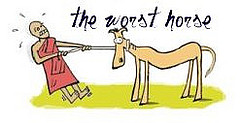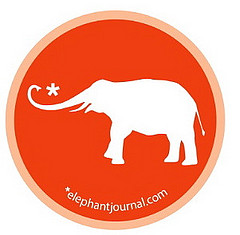The Daily OM newsletter was specifically relevant this week as I’ve been going through a bit of decision-making, stock-taking and overall refocus.
2010 had been a year in which I was searching for myself career-wise. I took some time off to return to school while I evaluated my options. At the end of the day, I’m so grateful to have had options as I know that there are so many people that are having tough times due to the current job market and economic conditions. It’s tough out there. Really tough.
I’m a loyal person. A serial monogamist in my romantic relationships. I really dislike change and much prefer a steady pace to life. My career hadn’t really been reflecting this as I’d made some wonky decisions (out of the desire just to be working somewhere - anywhere) and out of experimentation with a new career path which while it seemed interesting, held little promise in the long haul.
Being a Buddhist means that you ask a lot of questions and do quite a bit of self-analysis. I might be generalizing here, but you have to admit that having so much time meditating on the cushion leads you to follow your thoughts and get all introspective. It’s a given that we have a strong tendency to be a bit more conscious of our myriad of thoughts of “oh that isn’t a compassionate action”, “that’s not very mindful” or any laundry list of concepts, ideas, emotions and philosophies.
This specific Daily OM post below resonated with me as I am guilty of writing up lengthy lists of how I am feeling relating to certain trouble spots in my life. It’s helped me to gain some focus and make some of the tough decisions in my life.
If Only
Locating The Underlying Cause
If only I had a new car or a new house. Turn external thinking into internal thinking, it isn’t about the car or house.
Often, when we’re unhappy, we fall into the habit of thinking that, if only one or two particular things in our life would change, everything would be fine. We might focus on the fact that we need a new car, or a raise, or a change in our living situation. We dwell on this one thing and strategize, or complain, or daydream about what it would be like to have it. Meanwhile, underneath the surface, the real reason for our unhappiness sits unrecognized and unaddressed. And yet, if we are able to locate and explore the underlying cause of our discontent, all the surface concerns have a way of working themselves out in the light of our realization.
Maybe we really do just need a new car, and maybe moving to another city would improve our life situation. However, it can only help to take some time to explore what’s going on at a deeper level. Sometimes, when we take a moment and stop focusing on external concerns, we get to the heart of the matter. We might realize that all our lives we’ve been dissatisfied, grasping at one thing after another, only to be dissatisfied about something else once we get what we want. Or perhaps we’ll notice a pattern of running away from a place, or a relationship, when things get too hard. We might then wonder why this keeps happening, and how we might work through the difficulty rather than just escaping it. The point is, slowing down and turning our attention within can save us a lot of energy in the long run, because it is very often the case that there is no external change that will make us happy.
Once you’ve taken the time to inquire within, you can begin to make changes that address the deeper issue. This can be hard at first, especially if you’ve grown used to grasping for outside sources in order to quell your discontent, but in the end, you will be solving the problem at a deeper level, and it will be much less likely to recur.









This is good advice in a general sense however it lacks some specifics that may be useful.
In particular the activity relating to “wish-fulfillment” and/or “daydreaming” is amongst the most pervasively deleterious actions people undertake. This is not due to the immediate impact, but rather the massive amount of time and energy which is wasted little by little, and also the subtle reinforcements of these same wasteful motivations. Its a type of vicious cycle activity.
The daydreaming activity is a way for the mind to reinforce its patterns of response, by imagining scenarios and acting them out internally as if it was involved. This aspect of mind is like an engine that is always running, because it has an “idle” as well as a number of active gears. The idling keeps all the pistons moving along, it keeps the process in order - but its not an outward movement anywhere.
The images or symbols or stories of these daydreams are really little more than a surface film covering the actual activity, or the real energy of the process - which is most often emotional but can also be some particular sensory/sensation type experience. Unfortunately this reality is overlooked in favor of the content regarding the specific images or ideas or stories or words. As in, the person really thinks that the thoughts are the purpose of thinking, so they continue to reason the situation out, to mentally go over it and so forth. So, the process continues unabated.
But the actual purpose for this kind of thinking has nothing to do with the thoughts involved, rather it is the mind simply reinforcing its response patterns - or attempting to solidify itself by creating obsessively defined and rigid boundaries. It is achieved by becoming emotionally invested in the thought process, repeatedly, over and over and over and over - everyday for years and years. What people like to call “thinking” is usually nothing more than “daydreaming”. It is an unconscious motivation driving an unconscious process. It is a way of trying to freeze the energetic processes of mind, which would like to somehow attach itself to itself. Its like a dog chasing its tail.
So a key point to remember is that emotions and feelings (and sometimes sensations) are both the byproduct and the “payoff” of this kind of “thinking” or daydreaming. They are the meat of the process, the main force at work. It is not really about having ideas that indicate “I” will be going with “you” to a certain “place” where “things happen”, or whatever else, etc. etc. All of the images are irrelevant - they are tools of the process, and not actually “real”. They are not symbols for objects which are accurately defined. They are rather like name-tags slapped onto various edges of a turbulent storm-cloud.
Remembering this key point, we can therefore disregard the symbolic and linear time based aspect of “daydreams” (or the storyline, the plot, the description), and encounter this process in another way.. as an undifferentiated but at the same time specific set of feelings, emotions, sensations, etc. They may be pleasant or unpleasant, but at the most basic level, this is the main energy or fuel of the process - which is maintained by constant reinforcement or self-creation.
In a sense, we must digest this energy or fuel. What we do not realize in our unconsciousness is that the very daydreaming about things is what blocks us from experiencing the peace and joy we imagine we would get from those things, or alternately, the peace and joy we fear they will take from us. In other words, the daydreaming is a distortion of mind, which seeks to correct distortion of mind - without realizing it was the source of it in the first place. It works both in a positive and negative sense, because all of these internal constructs are self-perpetuating. It does not matter if it is pleasant or unpleasant experience - whatever is not fully digested or accepted is regarded as “other” and will remain as seed and have potential to sprout endlessly and find fruition from whatever internal or external process is available.
Eventually, if you encounter your daydreaming and “thinking” without getting caught by the content itself, but rather let the energy of the process wash over you without acting on it.. you will find it occurs less and less frequently until only vibrant space remains. This is a vibrancy fully attuned to the current moment of experience, and is therefore incredibly enriched by it.
The desire to seek fulfillment outside oneself is the very cause of non-fulfillment. There is a great amount of time and energy spent in daydreams, which has coalesced into self-perpetuating cycles of non-fulfillment. By letting this time and energy dissolve into a formless and undifferentiated experience, we can recover it. When it has become manifest in specific ideas and forms and images, in a sense we have lost it because we regard it as apart from us, as “other”. When it is allowed to remain as potential and raw energy, we will find we have recovered ourselves and our fulfillment.